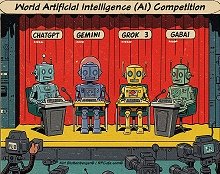Electronics & Technology
- See Full List of AI Topics -
Cable television has its roots in the early 1940s, when some communities in
the United States began experimenting with delivering television signals to
areas where over-the-air reception was poor due to distance or topography. These
early systems were known as "community antennas" or "CATV," and they involved
the use of large antennas mounted on hilltops to capture television signals and
distribute them via coaxial cables to subscribers in the surrounding area.
In the 1950s, the growth of the cable industry was driven by the desire of
people living in rural areas to receive television signals that were not
available via broadcast transmission. By the 1960s, cable had become a viable
alternative to broadcast television in many urban areas as well, as cable
providers began offering a wider range of channels and programming options.
The 1970s saw the introduction of satellite technology, which allowed cable
operators to expand their channel offerings and deliver programming from around
the world. The advent of cable networks like HBO and ESPN also helped to drive
the growth of the industry.
In the 1980s and 1990s, cable television became a major player in the media
landscape, with the consolidation of the industry leading to the emergence of
large media conglomerates like Comcast, Time Warner, and Viacom. The growth of
the internet and the emergence of new digital technologies have also had a
significant impact on the cable industry, with many cable providers now offering
high-speed internet and other digital services alongside traditional cable
television.
 This content was generated by primarily
the ChatGPT (OpenAI), and/or
Gemini (Google), and/or
Arya (GabAI), and/or
Grok (x.AI), and/or DeepSeek artificial intelligence (AI) engine.
Some review was performed to help detect and correct any inaccuracies; however,
you are encouraged to verify the information yourself if it will be used for critical
applications. In some cases, multiple solicitations to the AI engine(s) was(were) used to assimilate
final content. Images and external hyperlinks have also been added occasionally.
Courts have ruled that AI-generated content is not subject to copyright restrictions,
but since I modify them, everything here is protected by RF Cafe copyright. Many
of the images are likewise generated and modified. Your use of this data implies
an agreement to hold totally harmless Kirt Blattenberger, RF Cafe, and any and all
of its assigns. Thank you. Here are the major categories. This content was generated by primarily
the ChatGPT (OpenAI), and/or
Gemini (Google), and/or
Arya (GabAI), and/or
Grok (x.AI), and/or DeepSeek artificial intelligence (AI) engine.
Some review was performed to help detect and correct any inaccuracies; however,
you are encouraged to verify the information yourself if it will be used for critical
applications. In some cases, multiple solicitations to the AI engine(s) was(were) used to assimilate
final content. Images and external hyperlinks have also been added occasionally.
Courts have ruled that AI-generated content is not subject to copyright restrictions,
but since I modify them, everything here is protected by RF Cafe copyright. Many
of the images are likewise generated and modified. Your use of this data implies
an agreement to hold totally harmless Kirt Blattenberger, RF Cafe, and any and all
of its assigns. Thank you. Here are the major categories.
Electronics & High Tech
Companies | Electronics &
Tech Publications | Electronics &
Tech Pioneers | Electronics &
Tech Principles |
Tech Standards Groups &
Industry Associations | Societal
Influences on Technology
|







